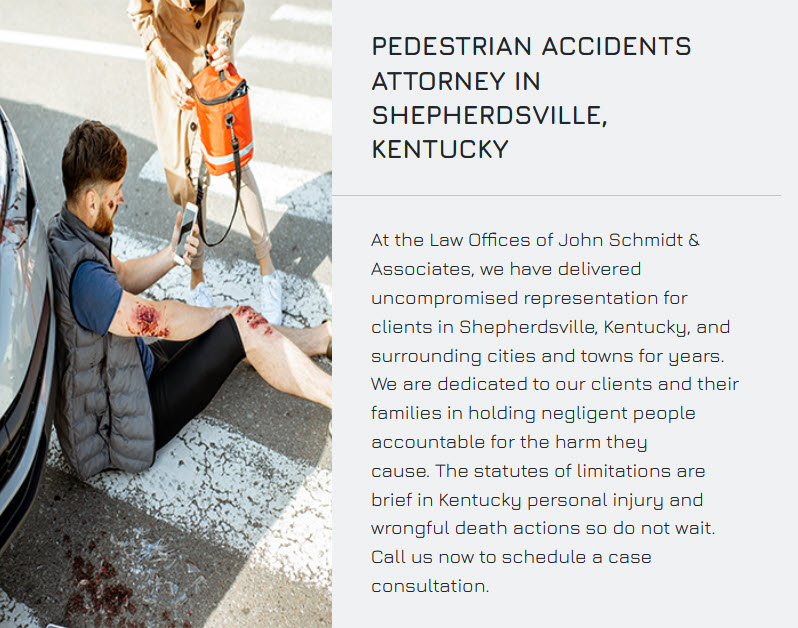PEDESTRIAN ACCIDENTS ATTORNEY IN SHEPHERDSVILLE, KENTUCKY
Whether a pedestrian is walking, jogging, or running, they are not a good match against a vehicle. Some victims are fortunate enough to walk away from an accident. Others sustain injuries ranging from minor to permanently incapacitating. For some, their injuries are fatal.
Pedestrian accident fatalities on Kentucky roadways jumped from 73 in 2019 to 92 in 2020. There were nearly 60 in the first 10 months of 2021. Going for a walk or a run should be a healthy activity, not a deadly one.
If you are a pedestrian hit by a car or the family member of someone who is incapacitated or loses their life, the Law Offices of John Schmidt & Associates can help. We serve clients in Shepherdsville, Kentucky, as well as those in Radcliff, Louisville, Jeffersontown, Elizabethtown, and Mount Washington.
We invite you to contact us via e-mail, schedule an appointment or call us today at (502) 509-1490 to get the important advice and counsel required to protect your personal injury claim and achieve full and fair compensation for having to endure and recover from your injuries.
Who Is at Fault for a Pedestrian Accident in Kentucky?
It is not true that the pedestrian always has the right of way. However, Kentucky’s right of way law does give it to the pedestrian most of the time. Vehicle operators must yield to pedestrians crossing in marked and unmarked crosswalks while walking on sidewalks, and when they are walking on the side of the roadway where no sidewalk is available.
Nonetheless, pedestrians also have responsibilities, such as obeying all traffic signs and signals. They must use sidewalks where available and cross roadways at intersections and always at a right angle. Like drivers, pedestrians owe a duty of care to others on Kentucky roadways and must remain vigilant at all times.
Both drivers and pedestrians can be assigned fault in an accident. Hazardous conditions can also contribute to fault. Such conditions include uneven road surfaces and potholes, unlighted roads and intersections, faulty traffic signals, and weather conditions causing slick roadways.
How is Fault Determined?
Negligence is the failure to exercise the care a prudent person would under the same circumstances. When someone’s negligence causes an incident that injures someone else and the victim incurs damages as a result, the negligent person can be held responsible for those damages.
Kentucky observes pure comparative negligence in personal injury and wrongful death claims, so fault can be assigned to more than one person. Let’s say you were crossing the street in a crosswalk obeying the traffic signal but were texting as you walked. A driver making a left turn strikes you. You could be assigned a percentage of fault for not paying attention, even though you had the right of way. If you are held 10% responsible, any financial recovery awarded to you would be reduced by your percentage of fault. If you were awarded $100,000, you would receive $90,000.
What are “Damages”?
Damages are the harms and losses you can recover in an insurance settlement or jury award. In a Kentucky personal injury claim, you can recover:
Medical expenses including future medical expenses;
Lost wages and future loss of income;
Pain and suffering;
Disfigurement; and,
Loss of consortium.
In a wrongful death claim, the estate of the decedent can recover funeral and burial expenses, estate administration costs, and legal expenses. Certain survivors, including a spouse, children, and parents, can recover damages such as loss of consortium, guidance, support, and income.
In either type of claim, a Kentucky jury may award punitive damages designed to punish a defendant for gross negligence or intent to harm.
How Long Do I Have to Pursue a Claim?
The time limit specified under Kentucky law for personal injury and wrongful death claims is a “statute of limitations.” This is the amount of time you have to either settle a claim with the negligent party’s insurance company or file a lawsuit in court.
For personal injury involving automobiles, the statute of limitations is two years from the date of the incident. For wrongful death claims, it is one year from the date the personal representative is appointed to administer the estate.
What Steps Do I Take Next?
The first step you should take is to consult with a personal injury attorney who can investigate the circumstances of the incident, document evidence, and help you pursue a claim or lawsuit. If your loved one has been incapacitated by their injuries and cannot pursue a claim on their own, the victim’s durable power of attorney can pursue a personal injury claim for them. If there is no durable power of attorney, the court can appoint a guardian for the incapacitated victim. You would need to petition the court for the appointment.
If your family member died as the result of their injuries, the personal representative of the estate can pursue a wrongful death claim. Again, you should consult with a wrongful death attorney to guide you through the process. The same evidence must be documented as that in a personal injury claim.
The insurance companies of negligent drivers will work diligently to prove their insureds were not at fault for your injuries or a loved one’s death. They will employ attorneys to represent them and their insureds. You need to retain a pedestrian accidents attorney who can document a claim, negotiate aggressively, and present your case to a jury if the insurance company refuses to settle for just compensation.
We invite you to contact us via e-mail, schedule an appointment or call us today at (502) 509-1490 to get the important advice and counsel required to protect your personal injury claim and achieve full and fair compensation for having to endure and recover from your injuries.





